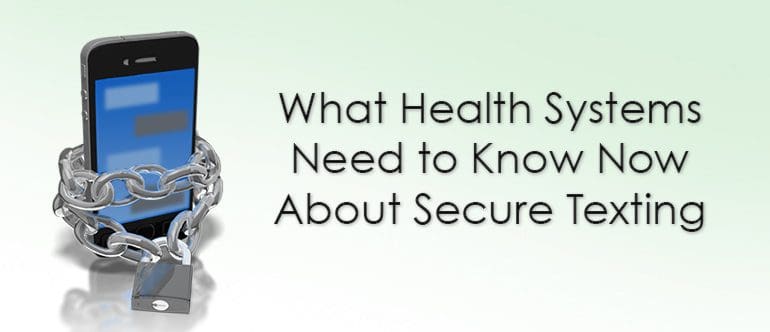Call us toll-free: 800-878-7828 — Monday - Friday — 8AM - 5PM EST


By Arun Mirchandani for For The Record
There has been a lot of talk recently about secure texting for medication and other types of medical orders. In the past several months, The Joint Commission announced that it was lifting—and then decided to delay lifting—its ban on texting orders while it works with the Centers for Medicare & Medicaid Services (CMS) “to ensure a safe implementation involving the secure texting of orders for those organizations desiring to employ technology supporting this practice.”
The initial secure texting guidelines by The Joint Commission were a start, but they are only one part of solving the larger problem of secure communication and collaboration within the health care environment. Any discussion of “texting orders” needs to engage the broader framework of how to address the people, process, and technology issues needed to enable such a workflow.
As we await the release of updated guidelines from The Joint Commission and CMS that could be released as early as this month, the following are some considerations that hospitals and health systems should keep in mind as they contemplate enabling texting orders—as well as any other clinically driven collaboration or notification workflow.
- Security. Is patient data protected? Are communications, including orders, being sent and processed according to an enterprise-wide privacy and security policy?
- Traceability. Can the communication status be tracked in real time? Can the sender confirm that the right person received the order and correctly interpreted it?
- Accessibility. Can the order be archived in the patient’s hospital records and other systems? Can information needed to process the order be pulled from the same system that is texting the order?
A Blueprint for Clinically Relevant Communication and Collaboration
We don’t know to what extent the above factors will be addressed in the final guidance from The Joint Commission and CMS. Historically, The Joint Commission favors using broader rather than prescriptive language. So let’s take a closer look at what health systems should be doing from a best practices standpoint.
First, clinical collaboration cannot be enabled by using a texting app downloaded from an app store. Ultimately, a clinically relevant communication like a texted medical order must securely reach the right person at the right time with the right information. There’s no way to ensure that outcome without certain built-in mechanisms for interaction—this disqualifies texting apps. Further, these types of solutions create islands of users and make securing the communication process nearly impossible.
In marked contrast, an enterprise collaboration platform can facilitate the more robust workflows required to achieve clinical collaboration, including issuing medication orders. As such, the ideal platform should include the following four key capabilities to securely and efficiently enable these workflows:
- A continuously updated master directory that identifies who is authorized and available. This insight can mean the difference between a texted order for pain medications that is carried out within minutes and one that drags out for half an hour or longer.
- Structured templates to facilitate accurate communication. Such templates can provide response options to ensure the order was received by the right person, contains all the required information, and is correctly interpreted.
- Connections to other systems. Interoperability with clinical systems such as EHRs and physiological monitors provides key contextual data about the patient while creating a record of the order so that care team members stay on the same page about the patient’s condition.
- Integrated workflow management. The ability to create, maintain, and optimize the robust clinical, communication, and business workflows that underlie the process of patient care is critical to ensuring the adoption and continued use of the communication system.
Enabling Texting Orders — More Than Just Technology
Note that none of the above capabilities were included in The Joint Commission’s prior guidelines for secure texting—and they may not be highlighted in the next.
Enabling secure collaboration is not a technology problem alone; it requires that we also engage people and workflow considerations and use technology to enable a secure and consistently usable process. Hospitals and health systems that are in the know have implemented—or are implementing—the following people and workflow guidelines for clinical collaboration and texting orders across the enterprise, in addition to directives by The Joint Commission.
- Specify how orders are placed and what information is provided. Specify and maintain a set of standardized templates (ones that conform to policy and medication management guidance) so it’s not left to the sender to remember what information to provide.
- Provide guidelines for who can receive texted orders, under what conditions the recipient can fulfill the orders, and how those permissions are managed. Identify a group of people that can receive and fulfill an order.
- Define when an order can be texted and when an alternative method must be used to send an order. This element of hospital policy is critical in managing appropriate use of a texting solution.
- Establish a way to track texted orders. This will allow quality and safety managers and technology leaders to gauge and manage the solution’s effectiveness.
Exciting changes are coming to health care providers that will enhance workflows and improve their satisfaction and patient safety. By following this guidance when the ban on texting orders is lifted, clinicians can enjoy this new way of communication without sacrificing convenience for security—or vice versa.
